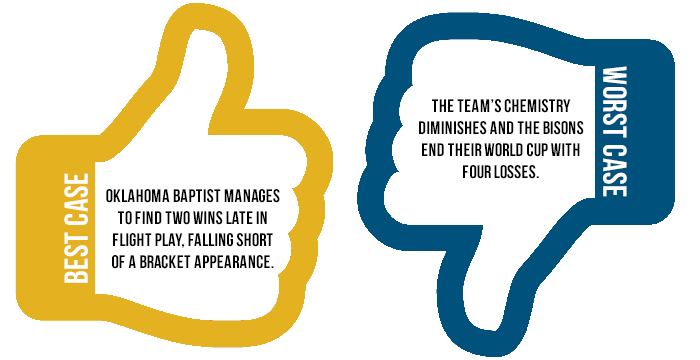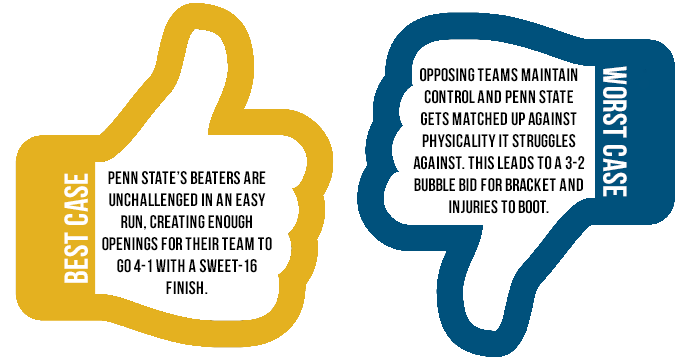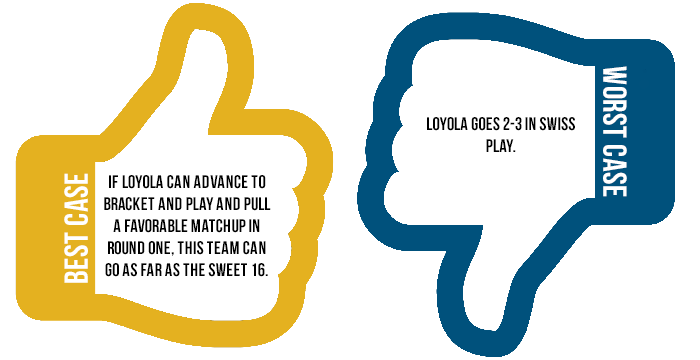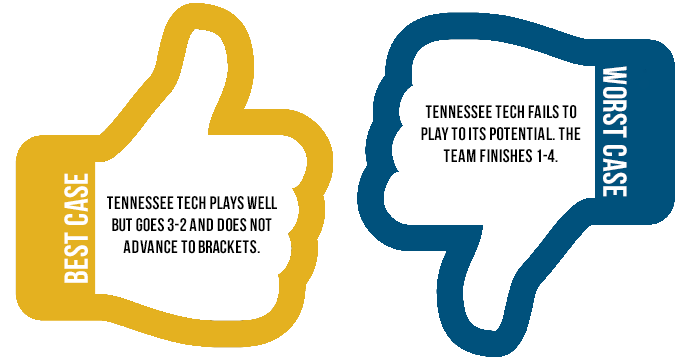Antwerp QC, Much of Belgian Core, Leaves Competitive Quidditch
Rock Hill Roll Call is your in-depth guide to the 80 teams that will compete for the title of World Cup 8 Champion. We’ve reached out to writers and analysts all over the country to bring you the lineups, strategies, focal points and aspirations of each and every attending team. Whether you are looking for a leg up on the competition or just want a detailed preview of the sport’s main event, this is the place for you.
 By Alex Wilson
By Alex Wilson
Oklahoma Baptist University has been on the rise since it was founded in 2012. Now the team has qualified for World Cup 8 after a season in which it almost upset several Top 20 teams.
The Bison have relied on their veteran players to contribute as usual, but at a school with only 2,000 students, recruiting has been their biggest focus and challenge. It is important to have threats beyond two people if there is any intention to stage an upset, and that is what Oklahoma Baptist has started to acquire. Chasers Alec Webber and Amy Bartel have been impact players for the Bison all year, and will have to come up big if they want to make a splash at World Cup.
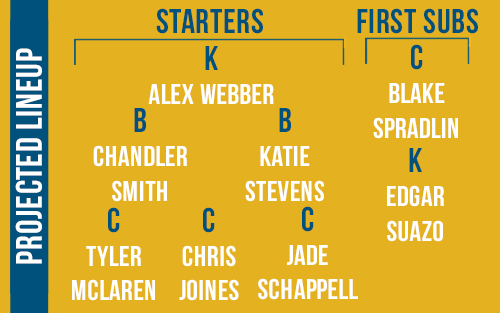 Webber adds consistency and play-making ability to both this team’s offense and the defense. He has developed well as he has gained experience, moving from a primary hero-baller to a team player who has the ability to drive and make people miss. Webber has good speed on the edge coupled with the ability to cut in quickly, but more importantly the focus to discern whether he should pass or drive. If Webber can get going, the goals should come regardless of this squad’s opponent.
Webber adds consistency and play-making ability to both this team’s offense and the defense. He has developed well as he has gained experience, moving from a primary hero-baller to a team player who has the ability to drive and make people miss. Webber has good speed on the edge coupled with the ability to cut in quickly, but more importantly the focus to discern whether he should pass or drive. If Webber can get going, the goals should come regardless of this squad’s opponent.
Every player fears a good ball carrier, but perhaps they should worry a little more about the receiver when they are as talented as Bartel. A newer player for Oklahoma Baptist, she has added what the Bison have lacked–a reliable female receiver. She uses good off-ball movement to slip through the cracks in the defense and become completely open before catching every ball that comes her way and finishing strong. When she is allowed to do what she is best at, she is easily the biggest threat on this team and should in no way be disregarded.
 By Alex Wilson
By Alex Wilson
Oklahoma Baptist is one of the more dangerous teams to play against, both in its style of play and mentality going into the game. Where most teams at the top find themselves playing a very similar brand of quidditch, the Bison have no disillusion of themselves as a top team. They are happy to embrace their underdog role and pair it with an unorthodox beating style that throws a lot of teams off.
The Bison seem to treat bludgers with reckless abandon due to the experience they have at beater. They are not afraid to come up with a bludger when they have one–or even two. This unpredictability will confuse a lot of teams early on, allowing Oklahoma Baptist to put up some quick points while it tries to hold on until the seeker floor, where its beating style will help close out games or climb back into range. On the chaser side, the Bison come to the pitch with a definite plan. They play a hard man defense with both a slow and fast offense, utilizing all of their players and waiting until their opponents make a mistake on defense.
Oklahoma Baptist is a team that is not afraid to push the envelope and knows that it has nothing to lose, which makes the Bison especially dangerous if they get to a 2-2 position on day one.
 By Ricky Nelson
By Ricky Nelson
Penn State University has made major strides to adapt this season. Going from a team knocked out in the quarterfinals of the Mid-Atlantic Regional to one that went 3-0 against World Cup qualifiers, including a finalist and semifinalist from the Mid-Atlantic regional, this squad has come a long way–it just is not enough.
In their last few practices, the Nittany Lions should have been devoted to developing longer range shots; however, almost every shot they took at Founder’s Cup was a dunk. Dunks are great—almost 100% chance it goes in if the chaser is in position to take the shot. But therein lies the problem: The chaser needs to be able to get there. Teams in the Southwest have more of that Crabbe and Goyle demographic, and Penn State needs an option that does not require it to go through that every time it wants to score.
Having the team’s male beaters practice together more might be a major boon. Though the Nittany Lions’ decision to play two female chasers may have been done due to a lack of females at beater, these two chasers were very effective at Founder’s Cup, particularly Sarah Kelly. The male beater set consisting of variations of Scott Axel, Jack Kulick and Josiah Hritsko, on the other hand, seemed flustered and confused, bunching up and leaving areas open. It may not be an issue at first at World Cup, but if the three concussions against UNC at the aforementioned Founder’s Cup is any indication, rosters can change unexpectedly.
 By Anonymous
By Anonymous
Penn State’s defense is basic—more basic than a sorority girl in Uggs at a Starbucks—with just a simple man-on-man defense with beaters at the center. Effective use of picks is a great way to deal with those pesky defenders, provided one does not run into a beater on the other side (and one probably will). The Nittany Lions’ beaters are strong, especially at the top of the roster. Couple them with defenders quick to react to a loose ball, and Penn State will get a lot of fast-break opportunities against unprepared teams.
 An opponent better get used to this team’s beaters because it will be seeing them on offense as well. The Nittany Lions’ beaters will bring up a bludger, with or without control, and turn defenses porous, creating chaos. This allows the ball carrier to charge in to score in those newly open lanes. If opposing players step in to fill those holes, Penn State will have chasers sitting at the hoops to score if they are left open.
An opponent better get used to this team’s beaters because it will be seeing them on offense as well. The Nittany Lions’ beaters will bring up a bludger, with or without control, and turn defenses porous, creating chaos. This allows the ball carrier to charge in to score in those newly open lanes. If opposing players step in to fill those holes, Penn State will have chasers sitting at the hoops to score if they are left open.
Assume Penn State’s beaters will hit you or catch bludgers that are catchable. Assume its chasers are scrappy enough to put the ball in regardless of whether you hit them when they are close to the hoops. Ultimately, just remember this is not the 9-7 team of the fall—this is the undefeated team of the spring.
 By Hank Dugie
By Hank Dugie
Loyola University New Orleans is not a team you want to play at World Cup 8. OK, sure, it beats playing the LA Gambits and the University of Baylors of the sport, but not even the best teams enjoy facing an opponent that has proven itself to be predictably unpredictable. With a win against the once-again relevant Texas A&M University at the Southwest Regional Championship, two to the once-relevant University of Miami at Wolfpack Classic and other victories including one over the maybe-relevant Sam Houston State University, Loyola has performed well this season and put together a nice resume going into the main event this April.
With the ability to run an effective two-male beater set consisting of Michael Gallaty and Tad Walters, this squad can maintain bludger control in the majority of contests. It can also thrive outside of this roster formation with the assistance of Alex Pucciarelli who will provide a less physical presence, but an even demeanor and sound strategic play. Look for Loyola to move seamlessly between these two sets as games progress.
While the team’s strength lies with its dodgeball-wielding comrades, it could not have been and will not continue to be successful this season without the pure athleticism and agility of Etefia Umana at chaser and his partners in the quaffle game: Drew Brekus and Nik Jablonski.
It is not yet clear how the Swiss system will affect most teams, but expect Loyola to be a squad that will show up big despite major tournament overhaul. If its beaters can hold onto their balls and control the tempo, this proud Pelican State team could advance to brackets.
 By Alex Wilson
By Alex Wilson
If there is one thing to say about playing Loyola, it is this: do not get this team in snitch range. The Wolf Pack have amassed a 10-2 record in snitch catch victories over the course of the season, with both losses coming within the first month of their season. This record can not only be attributed to the team’s excellent seeking, but also to its experienced and talented beating core. Loyola’s beaters do an excellent job of obtaining and maintaining bludger control. Utilizing 1.5 as often as possible, the beaters lay the groundwork for their team’s much-improved chaser lineup.
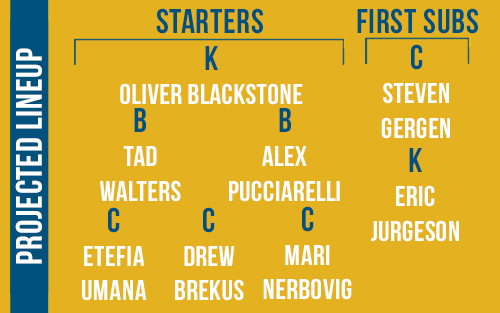 On the chaser side, Loyola likes to move the ball all around the hoops on offense, pulling the defense out before punishing them with a cut or pass to the hoops. On the outside, the Wolf Pack’s chasers have great speed and driving ability, which forces teams to respect them with multiple resources. Loyola’s chasers are extremely organized on defense, leaving no questions about assignments and making opponents work for every goal. These Wolf Pack quaffle players take what they are given and will play faster when they are up than when they are even or slightly down to make sure the game stays in range.
On the chaser side, Loyola likes to move the ball all around the hoops on offense, pulling the defense out before punishing them with a cut or pass to the hoops. On the outside, the Wolf Pack’s chasers have great speed and driving ability, which forces teams to respect them with multiple resources. Loyola’s chasers are extremely organized on defense, leaving no questions about assignments and making opponents work for every goal. These Wolf Pack quaffle players take what they are given and will play faster when they are up than when they are even or slightly down to make sure the game stays in range.
The success of this team’s beaters really catapults its whole game, and if Loyola can dominate early, opposing teams will find themselves struggling to claw their way out of range.
 By Tad Walters
By Tad Walters
Uncle Drew says, “Kids these days lack fundamentals.” Well, Uncle Drew has not seen Tennessee Tech University play quidditch.
While Tennessee Tech may not be an elite team, it is easily the most fundamentally sound quidditch team in the South Region. The Golden Hippogriffs’ offense is one of the most basketball-esque seen in recent memory, with their keepers using two-handed chest passes and their off-ball chasers making quick cuts in front of the hoops.
Aggressive offensive beating from Austin Lillis opens up driving lanes for the team’s best drivers, keeper Daniel Brys and chasers Logan Hartman and Michael Ferowich. The combination of aggressive beating and a smart, pass-heavy offense allows Tennessee Tech to make most of its points from within the keeper zone, whether on drives or one-pass plays. While few of the players on this team stand out as individual players, they all work as cogs in the Golden Hippogriff machine.
If they can play their game and not have to adapt to another team’s play style, Tennessee Tech will be a tough match up for any team in Rock Hill.
 By Anonymous
By Anonymous
While the above writer is correct in his statement that Tennessee Tech is a fundamentally-sound team, what he fails to really bring to light is its inability to reach greater heights and do more complex things on the field.
The Golden Hippogriffs struggle to finish at the hoops and tend to shoot or pass the ball at the nearest sign of contact, creating multiple turnovers for their opponents. Tennessee Tech also runs a zone defense, so it is weak in the transition game and susceptible to fast breaks when captain Lillis is over-aggressive with his bludger and loses it on the other side of the pitch.
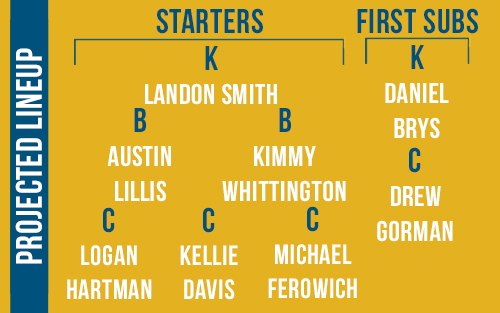 Lillis’ beating can make or break a game for the Golden Hippogriffs. When he is on, he plays aggressive with and without his bludger and makes great decisions on offense and defense. When he is off his game, he gets overzealous with his bludger, giving his opponents multiple no-bludger opportunities on offense.
Lillis’ beating can make or break a game for the Golden Hippogriffs. When he is on, he plays aggressive with and without his bludger and makes great decisions on offense and defense. When he is off his game, he gets overzealous with his bludger, giving his opponents multiple no-bludger opportunities on offense.
Within the zone, keeper Landon Smith shines, picking off shots and bad passes and using turnovers facilitated by Lillis to create fast-break opportunities. The Golden Hippogriffs will need Smith to play and finish strong if they want to make waves in Rock Hill.
Tennessee Tech’s biggest struggle is perhaps its seeker game. Charlie Jordan is basically the only seeker the Golden Hippogriffs utilize, and while he can tire a snitch out gradually over time, he is simply not a clutch seeker when the team needs him the most.
This squad will have to build upon its solid fundamentals if it plans to succeed this weekend.
Graphics and photo illustration by Amanda Dallas. Original photos by Nicole Harrig (top) and Matt Dwyer (bottom).
Archives by Month:
- May 2023
- April 2023
- April 2022
- January 2021
- October 2020
- September 2020
- July 2020
- May 2020
- April 2020
- March 2020
- February 2020
- January 2020
- December 2019
- November 2019
- October 2019
- August 2019
- April 2019
- March 2019
- February 2019
- January 2019
- November 2018
- October 2018
- September 2018
- August 2018
- July 2018
- June 2018
- April 2018
- March 2018
- February 2018
- January 2018
- November 2017
- October 2017
- July 2017
- June 2017
- May 2017
- April 2017
- March 2017
- February 2017
- January 2017
- December 2016
- November 2016
- October 2016
- September 2016
- August 2016
- July 2016
- June 2016
- May 2016
- April 2016
- March 2016
- February 2016
- January 2016
- December 2015
- November 2015
- October 2015
- September 2015
- August 2015
- July 2015
- June 2015
- May 2015
- April 2015
- March 2015
- February 2015
- January 2015
- December 2014
- November 2014
- October 2014
- September 2014
- August 2014
- July 2014
- May 2014
- April 2014
- March 2014
- February 2014
- January 2014
- November 2013
- October 2013
- September 2013
- August 2013
- July 2013
- June 2013
- May 2013
- April 2013
- March 2013
- February 2013
- January 2013
- December 2012
- November 2012
- October 2012
Archives by Subject:
- Categories
- Awards
- College/Community Split
- Column
- Community Teams
- Countdown to Columbia
- DIY
- Drills
- Elo Rankings
- Fantasy Fantasy Tournaments
- Game & Tournament Reports
- General
- History Of
- International
- IQA World Cup
- Major League Quidditch
- March Madness
- Matches of the Decade
- Monday Water Cooler
- News
- Positional Strategy
- Press Release
- Profiles
- Quidditch Australia
- Rankings Wrap-Up
- Referees
- Rock Hill Roll Call
- Rules and Policy
- Statistic
- Strategy
- Team Management
- Team USA
- The Pitch
- The Quidditch Lens
- Top 10 College
- Top 10 Community
- Top 20
- Uncategorized
- US Quarantine Cup
- US Quidditch Cup



